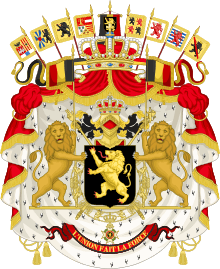Coat of arms of Belgium facts for kids
Quick facts for kids Coat of arms of Belgium |
|
|---|---|

Greater version
|
|
| Armiger | Albert II, King of the Belgians |
| Adopted | 17 March 1837 |
| Crest | A helmet with raised visor or crowned with a Royal Crown of Belgium |
| Blazon | Sable, a lion rampant or, armed and langued Gules with two crossed sceptres (a hand of justice and a lion) or behind a shield. The grand collar of the Order of Leopold (Belgium) surrounds the shield |
| Supporters | Two lions guardant proper each supporting a lance Gules point or with two National Flags of Belgium (Tierced per pale Sable, or and Gules. |
| Compartment | Underneath the compartment is placed the ribbon Gules with two stripes Sable charged with the motto |
| Motto | French: L'union fait la force Dutch: Eendracht maakt macht |
| Order(s) | Order of Leopold |
| Other elements | The whole is placed on a mantle Gules with ermine lining, fringes and tassels Or and ensigned with the Royal Crown of Belgium. Above the mantle rise banners with the arms of the nine provinces that made Belgium in 1837. They are (from right to left) Antwerp, West Flanders, East Flanders, Liège, Brabant, Hainaut, Limburg, Luxembourg and Namur |
The coat of arms of Belgium is an important national symbol. It features a powerful lion as its main design. This lion is known as the Leo Belgicus, which means "Belgian lion" in Latin. The colors used in the coat of arms are black, yellow, and red. These are the same colors you see on the Belgian flag. The national motto, "Unity makes strength," is also a key part of the design.
| Top - 0-9 A B C D E F G H I J K L M N O P Q R S T U V W X Y Z |
What is a Coat of Arms?
A coat of arms is a special design that represents a country, a family, or an organization. It's like a unique logo that tells a story about who it belongs to. Countries use them to show their history, values, and identity.
The Belgian Lion: A Symbol of Strength
The main part of Belgium's coat of arms is a golden lion. This lion stands on its back legs, ready to pounce. In heraldry, which is the study of coats of arms, this pose is called "rampant." The lion has red claws and a red tongue. It represents the strength and bravery of the Belgian people.
Colors and Their Meaning
The colors used in the coat of arms are:
- Black: This color is called sable in heraldry.
- Yellow: This color is called or (which means gold) in heraldry.
- Red: This color is called gules in heraldry.
These colors are the same as those on the Belgian flag. They stand for important parts of Belgian history and identity.
"Unity Makes Strength": The National Motto
Below the shield, there is a ribbon with the national motto. It is written in both French and Dutch, the two main languages of Belgium:
- L'union fait la force (French)
- Eendracht maakt macht (Dutch)
Both phrases mean "Unity makes strength." This motto reminds everyone that working together makes the country stronger.
Different Versions of the Coat of Arms
Belgium uses a few different versions of its coat of arms:
The Greater Coat of Arms
This is the most detailed version. It includes:
- The main shield with the golden lion.
- Two lions on either side, holding up Belgian flags. These are called "supporters."
- A royal crown on top, showing Belgium is a monarchy.
- A large red cloak, lined with ermine (a type of fur), draped behind the shield. This is called a "mantle."
- Banners above the mantle, showing the coats of arms of the nine original provinces that formed Belgium in 1837. These provinces are Antwerp, West Flanders, East Flanders, Liège, Brabant, Hainaut, Limburg, Luxembourg, and Namur.
- The Grand Collar of the Order of Leopold (Belgium), which is a very important Belgian award.
The Lesser Coat of Arms
This version is simpler. It usually shows:
- The shield with the lion.
- The two supporting lions.
- The royal crown.
- The motto ribbon.
You might see this version on official documents or buildings.
The Escutcheon-Only Version
This is the simplest version. It only shows the main shield with the golden lion. This version is often used when a smaller, less detailed symbol is needed, like on a passport.
History of the Coat of Arms
The coat of arms was officially adopted on March 17, 1837. This was just a few years after Belgium became an independent country in 1830. The design reflects the new nation's pride and its desire for unity.
Images for kids
See also
 In Spanish: Escudo de Bélgica para niños
In Spanish: Escudo de Bélgica para niños



